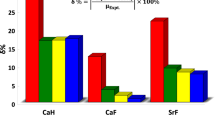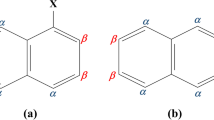Abstract
Solvent basicity is recognized as playing a major role in solvation and is included, through empirical basicity parameters, in linear free energy relationships that account for the effects of changes in solvent on chemical reactions. It is reasonable to postulate that the basicity of a solvent molecule reflects some combination of its molecular properties. In the present study, density functional calculations using the B3LYP functional, and Hartree–Fock calculations have been used to calculate the partial atomic charges (using the Hirshfeld and CM5 models), orbital energies, polarizabilities, dipole moments and quadrupolar amplitudes for over one hundred molecules for which there are experimental values for two basicity parameters, Kamlet and Taft’s hydrogen bond acceptor strength, β, and Gutmann’s donor number, DN, a measure of Lewis basicity. Regression of the experimental β and DN values against molecular descriptors reflecting the above molecular properties yields a remarkably consistent picture. For both parameters the values for alcohols and amines lie systematically off of the regression lines through the remaining compounds, which include alkanes, aromatics, halogenated alkanes and aromatics, esters, carbonates, carboxylic acids, ketones, ethers, nitriles, phosphates, sulfides and sulfates. Independent of the calculation method or method of estimating the partial atomic charges, both experimental β and DN are essentially determined by two molecular properties: the charge on the most negative atom of the molecule and the molecular orbital from which charge donation would occur. The regression results using any of the fours sets of descriptors (reflecting the two calculation methods and two methods of charge estimation) are remarkably similar for β and DN supporting the view that these are measures of the same “basicity”.





Similar content being viewed by others
Notes
The quadrupolar amplitude is calculated as \( A = \sqrt {\sum {q_{ij} q_{ij}}} \quad i = x,y,z\quad j = x,y,z \) where the qij are the components of the traceless quadrupole.
References
Svante Arrhenius, S.A.: Recherches sur la Conductivité Galvanique des Électrolytes. Doctoral Dissertation, Stockholm, Royal Publishing House, P.A. Norstedt and Söner (1884)
Brönsted, J.N.: Einige bemerkungen über den begriff der säuren und basen. Rec. des Trav. Chim. Pays-Bas 42, 718–728 (1923)
Lowry, T.M.: The uniqueness of hydrogen. J. Soc. Chem. Ind. 42, 43–47 (1923)
Lewis, G.N.: Valence and the Structure of Atoms and Molecules. American Chemical Society Monograph Series, vol. 14. The Chemical Catalog Co., Inc., New York (1923)
Jensen, W.B.: The Lewis acid–base definitions: a status report. Chem. Rev. 78, 1–22 (1978)
Kamlet, M.J., Taft, R.W.: Linear solvation energy relationships–local empirical rules or fundamental laws of chemistry—a reply to the chemometricians. Acta Chem. Scand. 39, 611–628 (1985)
Marcus, Y.: The properties of organic liquids that are relevant to their use as solvating solvents. Chem. Soc. Rev. 22, 409–416 (1993)
Sandström, M., Persson, I., Person, P.: A study of solvent electron-pair donor ability and Lewis basicity scales. Acta Chem. Scand. 44, 653–675 (1990)
Gutmann, V.: Empirical parameters for donor and acceptor properties of solvents. Electrochim. Acta 21, 661–670 (1976)
Kamlet, M.J., Taft, R.W.: The solvatochromic comparison method. I. The β-scale of solvent hydrogen-bond acceptor (HBA) basicities. J. Am. Chem. Soc. 98, 377–383 (1976)
Eckert, F., Clampt, A.: Accurate prediction of basicity in aqueous solution with COSMO-RS. J. Compd. Chem. 27, 11–19 (2006)
Schwöbel, J., Ebert, R.-U., Kühne, R., Schüürmann, G.: Predictioon of the intrinsic hydrogen bond acceptor strength of organic compounds by local molecular parameters. J. Chem. Inf. Model. 49, 956–962 (2009)
Green, A.J., Popelier, P.L.A.: Theoretical prediction of hydrogen-bond basicity pK BHX using quantum chemical topology descriptors. J. Chem. Inf. Model. 54, 553–561 (2014)
Kaupmees, K., Trummal, A., Leito, I.: Basicities of strong bases in water: a computational study. Croat. Chem. Acta 87, 385–395 (2014)
Le Questel, J.-Y., Berthelot, M., Laurence, C.: Can semi-empirical calculations yield reasonable estimates of hydrogen-bonding basicity? The case of nitriles. J. Chem. Soc. Perkin Trans 2, 711–719 (1997)
Seybold, P.G., Kreye, W.C.: Theoretical estimation of the acidities of alcohols and azoles in gas phase, DMSO and water. Int. J. Quant. Chem. 112, 3769–3776 (2012)
Safi, Z.S., Omar, S.: Proton affinity and molecular basicity of m- and p-supstituted benzamieds in gas phase and solution: a theoretical study. Chem. Phys. Lett. 611–612, 321–330 (2014)
Katritzky, A.R., Fara, D.C., Yang, H., Tamm, K., Tamm, T., Karelson, M.: Quantitative measures of solvent polarity. Chem. Rev. 104, 175–198 (2004)
Devereux, M., Popelier, P.L.A., McLay, I.M.: A refined model for prediction of hydrogen bond acidity and basicity parameters from quantum mechanical descriptors. Phys. Chem. Chem. Phys. 11, 1595–1603 (2009)
Caclelli, I., Campanile, S., Giolitti, A., Molin, D.: Theoretical prediction of Abraham hydrogen bond acidity and basicity factors from a reaction field method. J. Chem. Inf. Model. 45, 3237–3333 (2005)
Frisch, M.J., Trucks, G.W., Schlegel, H.B., Scuseria, G.E., Robb, M.A., Cheeseman, J.R., Scalmani, G., Barone, V., Mennucci, B., Petersson, G.A., Nakatsuji, H., Caricato, M., Li, X., Hratchian, H.P., Izmaylov, A.F., Bloino, J., Zheng, G., Sonnenberg, J.L., Hada, M., Ehara, M., Toyota, K., Fukuda, R., Hasegawa, J., Ishida, M., Nakajima, T., Honda, Y., Kitao, O., Nakai, H., Vreven, T., Montgomery, J.A., Peralta, J.E., Ogliaro, F., Bearpark, M., Heyd, J.J., Brothers, E., Kudin, K.N., Staroverov, V.N., Kobayashi, R., Normand, J., Raghavachari, K., Rendell, A., Burant, J.C., Iyengar, S.S., Tomasi, J., Cossi, M., Rega, N., Millam, J.M., Klene, M., Knox, J.E., Cross, J.B., Bakken, V., Adamo, C., Jaramillo, J., Gomperts, R., Stratmann, R. E., Yazyev, O., Austin, A.J., Cammi, R., Pomelli, C., Ochterski, J.W., Martin, E.L., Morokuma, K., Zakrzewski, V.G., Voth, G.A., Salvador, P., Dannenberg, J.J., Dapprich, S., Daniels, A.D., Farkas, O., Foresman, J.B., Ortiz, J.V., Cioslowski, J., Fox, D.J.: Gaussian 09 ed. Gaussian, Inc., Wallingford, CT (2009)
Hahn, S., Miller, W.M., Lichtehthaler, R.N., Prausnitz, J.M.: Donor number estimation for oxygen- and nitrogen-containing solvents via proton NMR shift of chloroform. J. Solution Chem. 14, 129–137 (1985)
Rzeszotarska, J., Ranachowski, P., Kalinowski, M.K.: Donor numbers in binary mixtures of dimethyl sulfoxide with dipolar aprotic solvents. Collect. Czech. Chem. Commun. 59, 2201–2208 (1994)
Greenberg, M.S., Popov, A.I.: Spectroscopic studies of ionic solvation. 17. Studies of preferential solvation of sodium ion in non-aqueous mixed solvent by 23Na nuclear magnetic resonance. Spectrochim. Acta A 31, 697–705 (1975)
Acknowledgements
This study was supported by University College Dublin.
Author information
Authors and Affiliations
Corresponding author
Electronic supplementary material
Below is the link to the electronic supplementary material.
Rights and permissions
About this article
Cite this article
Earle Waghorne, W., O’Farrell, C. Solvent Basicity, A Study of Kamlet–Taft β and Gutmann DN Values Using Computationally Derived Molecular Properties. J Solution Chem 47, 1609–1625 (2018). https://doi.org/10.1007/s10953-018-0791-3
Received:
Accepted:
Published:
Issue Date:
DOI: https://doi.org/10.1007/s10953-018-0791-3




